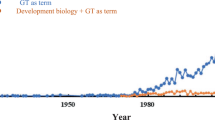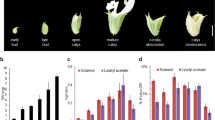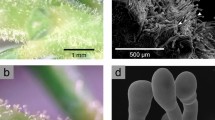Abstract
Successful biochemical reactions in organisms necessitate compartmentalization of the requisite components. Glandular trichomes (GTs) act as compartments for the synthesis and storage of specialized compounds. These compounds not only are crucial for the survival of plants under biotic and abiotic stresses but also have medical and commercial value for humans. However, the mechanisms underlying compartmentalization remain unclear. Here we identified a novel structure that is indispensable for the establishment of compartments in cucumber GTs. Silica, a specialized compound, is deposited on the GTs and is visible on the surface of the fruit as a white powder, known as bloom. This deposition provides resistance against pathogens and prevents water loss from the fruits1. Using the cucumber bloomless mutant2, we discovered that a lignin-based cell wall structure in GTs, named ‘neck strip’, achieves compartmentalization by acting as an extracellular barrier crucial for the silica polymerization. This structure is present in the GTs of diverse plant species. Our findings will enhance the understanding of the biosynthesis of unique compounds in trichomes and provide a basis for improving the production of compounds beneficial to humans.
This is a preview of subscription content, access via your institution
Access options
Access Nature and 54 other Nature Portfolio journals
Get Nature+, our best-value online-access subscription
$29.99 / 30 days
cancel any time
Subscribe to this journal
Receive 12 digital issues and online access to articles
$119.00 per year
only $9.92 per issue
Buy this article
- Purchase on Springer Link
- Instant access to full article PDF
Prices may be subject to local taxes which are calculated during checkout




Similar content being viewed by others
Data availability
The RNA sequencing data are deposited to National Center for Biotechnology Information under BioProject ID PRJNA925542. Source data are provided with this paper.
Code availability
The code for RNA sequencing is deposited at https://doi.org/10.5281/zenodo.10344857.
References
Samuels, A. L., Glass, A. D. M., Ehret, D. L. & Menzies, J. G. The effects of silicon supplementation on cucumber fruit: changes in surface characteristics. Ann. Bot. 72, 433–440 (1993).
Hao, N. et al. CsMYB36 is involved in the formation of yellow green peel in cucumber (Cucumis sativus L.). Theor. Appl. Genet. 131, 1659–1669 (2018).
Chiba, H., Osanai, M., Murata, M., Kojima, T. & Sawada, N. Transmembrane proteins of tight junctions. Biochim. Biophys. Acta 1778, 588–600 (2008).
Caspary, R. Bemerkungen über die Schutzscheide und die Bildung des Stammes und der Wurzel. Jahrb. wissensc. Botanik 4, 101–124 (1865).
Pfister, A. et al. A receptor-like kinase mutant with absent endodermal diffusion barrier displays selective nutrient homeostasis defects. Elife 3, e03115 (2014).
Kamiya, T. et al. The MYB36 transcription factor orchestrates Casparian strip formation. Proc. Natl Acad. Sci. USA 112, 10533–10538 (2015).
Glas, J. J. et al. Plant glandular trichomes as targets for breeding or engineering of resistance to herbivores. Int. J. Mol. Sci. 13, 17077–17103 (2012).
Huchelmann, A., Boutry, M. & Hachez, C. Plant glandular trichomes: natural cell factories of high biotechnological interest. Plant Physiol. 175, 6–22 (2017).
Adebesin, F. et al. Emission of volatile organic compounds from petunia flowers is facilitated by an ABC transporter. Science 356, 1386–1388 (2017).
Schuurink, R. & Tissier, A. Glandular trichomes: micro-organs with model status? New Phytol. 225, 2251–2266 (2020).
Tissier, A., Morgan, J. A. & Dudareva, N. Plant volatiles: going ‘in’ but not ‘out’ of trichome cavities. Trends Plant Sci. 22, 930–938 (2017).
Plachno, B. J., Stpiczynska, M., Adamec, L., Miranda, V. F. O. & Swiatek, P. Nectar trichome structure of aquatic bladderworts from the section Utricularia (Lentibulariaceae) with observation of flower visitors and pollinators. Protoplasma 255, 1053–1064 (2018).
Cardoso-Gustavson, P. & Davis, A. R. Is nectar reabsorption restricted by the stalk cells of floral and extrafloral nectary trichomes? Plant Biol. 17, 134–146 (2015).
Yamamoto, Y. Studies on bloom on the surface of cucumber fruits. 2. Relation between the degree of bloom occurrence and contents of mineral elements. Bull. Fukuoka Agric. Res. Cent. 9, 1–6 (1989).
Tripathi, D., Dwivedi, M. M., Tripathi, D. K. & Chauhan, D. K. Silicon bioavailability in exocarp of Cucumis sativus Linn. 3 Biotech 7, 386 (2017).
Dayanandan, P., Kaufman, P. B. & Franklin, C. I. Detection of silica in plants. Am. J. Bot. 70, 1079–1084 (1983).
Yokoyama, R. et al. Histochemical staining of silica body in rice leaf blades. Bio Protoc. 5, 19 (2015).
Ichimura, K., Funabiki, A., Aoki, K.-I. & Akiyama, H. Solid phase adsorption of crystal violet lactone on silica nanoparticles to probe mechanochemical surface modification. Langmuir 24, 6470–6479 (2008).
Roppolo, D. et al. A novel protein family mediates Casparian strip formation in the endodermis. Nature 473, 380–383 (2011).
Lee, Y., Rubio, M. C., Alassimone, J. & Geldner, N. A mechanism for localized lignin deposition in the endodermis. Cell 153, 402–412 (2013).
Ursache, R., Andersen, T. G., Marhavý, P. & Geldner, N. A protocol for combining fluorescent proteins with histological stains for diverse cell wall components. Plant J. 93, 399–412 (2018).
Naseer, S. et al. Casparian strip diffusion barrier in Arabidopsis is made of a lignin polymer without suberin. Proc. Natl Acad. Sci. USA 109, 10101–10106 (2012).
Kolbeck, A. et al. CASP microdomain formation requires cross cell wall stabilization of domains and non-cell autonomous action of LOTR1. eLife 11, e69602 (2022).
Liao, P. et al. Cuticle thickness affects dynamics of volatile emission from petunia flowers. Nat. Chem. Biol. 17, 138–145 (2021).
Kamtsikakis, A. et al. Asymmetric water transport in dense leaf cuticles and cuticle-inspired compositionally graded membranes. Nat. Commun. 12, 1267 (2021).
Hosmani, P. S. et al. Dirigent domain-containing protein is part of the machinery required for formation of the lignin-based Casparian strip in the root. Proc. Natl Acad. Sci. USA 110, 14498–14503 (2013).
Lacombe, E. et al. Cinnamoyl CoA reductase, the first committed enzyme of the lignin branch biosynthetic pathway: cloning, expression and phylogenetic relationships. Plant J. 11, 429–441 (1997).
Goujon, T. et al. A new Arabidopsis thaliana mutant deficient in the expression of O-methyltransferase impacts lignins and sinapoyl esters. Plant Mol. Biol. 51, 973–989 (2003).
Yano, R. et al. Comparative genomics of muskmelon reveals a potential role for retrotransposons in the modification of gene expression. Commun. Biol. 3, 432 (2020).
Zhou, J., Lee, C., Zhong, R. & Ye, Z. H. MYB58 and MYB63 are transcriptional activators of the lignin biosynthetic pathway during secondary cell wall formation in Arabidopsis. Plant Cell 21, 248–266 (2009).
Yano, R., Nonaka, S. & Ezura, H. Melonet-DB, a grand RNA-seq gene expression atlas in Melon (Cucumis melo L.). Plant Cell Physiol. 59, e4 (2018).
Fahn, A. Secretory tissues in vascular plants. New Phytol. 108, 229–257 (1988).
Tamura, K., Stecher, G., Peterson, D., Filipski, A. & Kumar, S. MEGA6: molecular evolutionary genetics analysis version 6.0. Mol. Biol. Evol. 30, 2725–2729 (2013).
Letunic, I. & Bork, P. Interactive Tree Of Life (iTOL) v5: an online tool for phylogenetic tree display and annotation. Nucleic Acids Res. 49, W293–W296 (2021).
Liu, H. et al. CRISPR-P 2.0: an improved CRISPR-Cas9 tool for genome editing in plants. Mol. Plant 10, 530–532 (2017).
Liu, H. J. et al. High-throughput CRISPR/Cas9 mutagenesis streamlines trait gene identification in maize. Plant Cell 32, 1397–1413 (2020).
Hu, B. et al. Engineering non-transgenic gynoecious cucumber using an improved transformation protocol and optimized CRISPR/Cas9 system. Mol. Plant 10, 1575–1578 (2017).
Livak, K. J. & Schmittgen, T. D. Analysis of relative gene expression data using real-time quantitative PCR and the 2−ΔΔCT method. Methods 25, 402–408 (2001).
Liu, X. et al. PINOID is required for lateral organ morphogenesis and ovule development in cucumber. J. Exp. Bot. 70, 5715–5730 (2019).
Li, Q. et al. A chromosome-scale genome assembly of cucumber (Cucumis sativus L.). GigaScience 8, giz072 (2019).
Kim, D., Paggi, J. M., Park, C., Bennett, C. & Salzberg, S. L. Graph-based genome alignment and genotyping with HISAT2 and HISAT-genotype. Nat. Biotechnol. 37, 907–915 (2019).
Li, H. et al. The Sequence Alignment/Map format and SAMtools. Bioinformatics 25, 2078–2079 (2009).
Liao, Y., Smyth, G. K. & Shi, W. FeatureCounts: an efficient general purpose program for assigning sequence reads to genomic features. Bioinformatics 30, 923–930 (2014).
Robinson, M. D., McCarthy, D. J., & Smyth, G. K. edgeR: a Bioconductor package for differential expression analysis of digital gene expression data. Bioinformatics 26, 139–140 (2010).
Pighin, J. A. et al. Plant cuticular lipid export requires an ABC transporter. Science 306, 702–704 (2004).
Schindelin, J. et al. Fiji: an open-source platform for biological-image analysis. Nat. Methods 28, 676–682 (2012).
Fischer, A. C., Steinebach, O. M., Timmermans, K. R. & Wolterbeek, H. T. A method for the destruction and analysis of biogenic silicon in two Antarctic diatom species: Thalassiosira sp. and Chaetoceros brevis. J. Appl. Phycol. 19, 71–77 (2007).
Friml, J., Benková, E., Mayer, U., Palme, K. & Muster, G. Automated whole mount localisation techniques for plant seedlings. Plant J. 34, 115–124 (2003).
Sauer, M., Paciorek, T., Benková, E. & Friml, J. Immunocytochemical techniques for whole-mount in situ protein localization in plants. Nat. Protoc. 1, 98–103 (2006).
Lescot, M. et al. PlantCARE, a database of plant cis-acting regulatory elements and a portal to tools for in silico analysis of promoter sequences. Nucleic Acids Res. 30, 325–327 (2002).
Acknowledgements
We thank M. Saiki, C. Masuda and Y. Kawara for providing technical support, and we also thank M. Tanaka and Y. Shikanai for their guidance on the immunolocalization experiment. Funding: Japan Society for the Promotion of Science (JSPS) KAKENHI grant 21H02087, 17H03782 (T.K.). Japan–China Scientific Cooperation Program between JSPS and NSFC (3201154000) (T.W., T.K.). Japan Society for the Promotion of Science (JSPS) KAKENHI grant 18H05490, 19H05637 (T.F.). Hunan Provincial Recruitment Program of Foreign Experts (T.W., T.F.). National Natural Science Foundation of China (U21A20234) (B.L.). National Natural Science Foundation of China (31972429) (T.W.). Hunan Provincial Natural Science Foundation of China (2021JJ10032) (T.W.). Scientific Research on Innovative Areas IBmS: Japan Society for the Promotion of Science (JSPS) KAKENHI (JP19H05771) (M.S.).
Author information
Authors and Affiliations
Contributions
Conceptualization: N.H., T.W, T.F. and T.K. Methodology: N.H. and T.K. Investigation: N.H., H.Y., C.W., M.S., J.C. and T.K. Visualization: N.H. and T.K. Funding acquisition: T.W., T.F. and T.K. Project administration: T.W., T.F. and T.K. Supervision: T.W., T.F. and T.K. Writing – original draft: N.H. and T.K. Writing – review and editing: N.H., T.W., B.L., T.F. and T.K.
Corresponding authors
Ethics declarations
Competing interests
The authors declare no competing interests.
Peer review
Peer review information
Nature Plants thanks the anonymous reviewers for their contribution to the peer review of this work.
Additional information
Publisher’s note Springer Nature remains neutral with regard to jurisdictional claims in published maps and institutional affiliations.
Extended data
Extended Data Fig. 1 Phenotypic analysis of csmyb36 mutant lines.
(a) Mutation sites and gRNA target regions in CsMYB36. CsMYB36-CR1 and CsMYB36-CR2 are two independent CRIPSR lines of CsMYB36. (b) 10 DAA fruit phenotype of the CsMYB36 mutant lines. The representative images were shown among 3 biologically independent samples. (c) Quantitative analysis of bloom on the fruit surface of WT and ygp mutant (means ± SD). n = 3 biologically independent samples, unpaired two-tails Student’s t-test (****P < 0.0001). (d) Quantitative analysis of bloom on the fruit surface of WT and two independent CRISPR lines of CsMYB36 (means ± SD). n = 5 biologically independent samples, Student’s t-test (****P < 0.0001). (e) Expression level of CsCASP1 in CsMYB36 CRISPR lines in the fruit of 0 DAA (means ± SD). n = 3 biologically independent samples. (f) Si concentration in the cucumber fruit of WT and CsMYB36 CRISPR lines by ICP-MS analysis (means ± SD). n = 5 biologically independent samples, Student’s t-test (ns, P ≥ 0.05). Dots represent individual data. Scale bars, (B) 5 cm.
Extended Data Fig. 2 Bloom formation was determined by the shoot genotype.
Comparison of the amount of bloom on the 10 DAA fruit of grafting plants between the WT and ygp mutant (mean ± SD); n = 3 biologically independent samples, Student’s t-test (ns, P ≥ 0.05; ****P < 0.0001).
Extended Data Fig. 3 SEM-EDS analysis on the surface of GT on the cucumber fruit surface.
The SEM-EDS analysis was performed on the red point (spot) on the GT of the WT (A, B),ygp mutant (C, D), WT for CRISPR lines (E, F), CsMYB36-CR1 (G, H), and CsMYB36-CR2 (I, J). One of two images taken with different samples is shown here. Zero DAA fruits were used for the analysis. (B), (D), (F), (H) and (J) show the percentage of mass concentration for every genotype in (A), (C), (E), (G)and (I), respectively. Each dot in (B), (D), (F), (H) and (J) represents one image. The experiment for (A), (C), (E), (G) and (I) was repeated independently twice and results are similar. Scale bars: (A, C, E, G, I) 6 µm.
Extended Data Fig. 4 CsMYB36 can directly bind to the CsCASP1 promoter.
(a) Schematic diagrams of four predicted MYB transcription factor binding motifs at the promoter sequence of CsCASP1. Two fragments (CsCASP1-1 and CsCASP1-2) containing two cis-element was fused into prey vector, respectively. (b) Binding of CsMYB36 to CsCASP1 promoter sequence using yeast one-hybrid assays. Yeast cultures grown in YPDA media (OD600 = 0.2 × 10°, × 10−1, × 10−2) were spotted to SD-TLH media containing 0, 10, 20, 30 mM 3AT, respectively. (c) Schematic diagrams of the effector and reporter constructs used for dual-luciferase assays. (d) Representative images of dual-luciferase reporter assay. Luminescence was captured after infiltration of each construct into Nicotiana benthamiana leaves. The left side of the leaf is for CsCASP1-1, and the right side of the leaf is for CsCASP1-2. MYB36-SK + LUC and empty-62-SK + LUC are the negative control. Empty 62-SK+CsCASP1-1-LUC and CsCASP1-2-LUC are the background control. (e) Quantification of dual-luciferase reporter assay of CsMYB36 and CsCASP1-2. The data are means ± SD, n = 4 biologically independent samples, Student’s t-test (*, P < 0.05). Dots represent individual data.
Extended Data Fig. 5 Localization of CsCASP1 on the cucumber fruit surface of WT.
(a-c) Z-stack confocal image of Calcofluor White (cellulose) (A) and anti-CsCASP1 antibody (B) in the GT of WT fruit. (c) Merged image of (A) and (B). The experiment for (A) to (C) was repeated at least three times and the results were consistent. Cucumber fruit samples are approximately 3–4 days before anthesis. Scale bars: (A–C) 50 μm.
Extended Data Fig. 6 Lignin deposition in the GT was not detected in the ygp mutant and CsMYB36 CRISPR lines.
(a–i) Z-stack confocal image of Calcofluor White (A, D, G) and Basic Fuchsin (B, E, H) staining, in the fruit peel of ygp mutant, CsMYB36-CR1, CsMYB36-CR2, respectively. (c, f, i) is the merged image of (A) and (B), (D) and (E), (G) and (H), respectively. The experiment for (A) to (I) was repeated independently at least three times and the results are similar. Cucumber fruit samples were collected approximately 3–4 days before anthesis. Scale bars: (A–I) 10 µm.
Extended Data Fig. 7 Cuticle layer on the surface of GT.
GT on the fruit peel was stained with Calcofluor White (cellulose) (a) and Nile Red (cuticle) staining (b) and observed via confocal microscopy. (c) Merged image. The experiment for (A) to (C) was repeated independently twice and the results were consistent. Cucumber fruit samples were collected approximately 3–4 days before anthesis. Scale bars, 10 µm.
Extended Data Fig. 8 Plasmodesmata in cucumber fruit GTs.
(a) Electron microscopy image of a GT stained with KMnO4. The experiment for (A) was repeated independently three times and the results are similar. The image is the same as Fig. 3d. (b–i) Magnified region of the boxes in (A). The white arrowheads in (B–E) indicate the presence of plasmodesmata. GC, gland cell; NC, neck cell; SC, stalk cell; BC, basal cell; EC, epidermal cell. Scale bars: (A) 10 µm and (B–I) 1 µm.
Extended Data Fig. 9 CsCASP1 immunolocalization pattern in the root of WT and ygp mutant.
(a-c) Immunolocalization using anti-CsCASP1 antibody in the root of WT (A-C). (d-f) Immunolocalization using anti-CsCASP1 antibody in the root of ygp mutant. The experiment for (A) and (F) was repeated at least twice and the results are similar. Scale bars: 50 µm.
Extended Data Fig. 10 CS phenotype observation in the root of WT and ygp mutant.
(a-c) Lignin and cellulose staining by Calcofluor White (A) and basic fuchsin (B) in the root of WT. The experiment for (A) and (C) was repeated at least twice and the results are similar. (C) is merge image of (A) and (B). A’, B’ and C’ are the magnified image of the white box in A, B and C, respectively. (d-f) Lignin and cellulose staining by Calcofluor White (D) and basic fuchsin (E) in the root of ygp mutant. The experiment for (D) and (F) was repeated at least twice and the results are similar. (F) is merge image of (D) and (E). A’, B’ and C’ are the magnified image of the white box in A, B and C, respectively. D’, E’ and F’ are magnified image of D, E and F, respectively. Scale bars: 50 µm.
Supplementary information
Supplementary Information
Supplementary Figs. 1–3.
Supplementary Tables 1–3
List of down-regulated genes (FDR < 0.05) in the fruit peel of ygp mutant. Accession numbers of the genes used in the phylogenetic tree. Primers used in this study.
Source data
Source Data Fig. 1
Statistical source data.
Source Data Fig. 2
Statistical source data.
Source Data Extended Data Fig. 1
Statistical source data.
Source Data Extended Data Fig. 2
Statistical source data.
Source Data Extended Data Fig. 4
Statistical source data.
Rights and permissions
Springer Nature or its licensor (e.g. a society or other partner) holds exclusive rights to this article under a publishing agreement with the author(s) or other rightsholder(s); author self-archiving of the accepted manuscript version of this article is solely governed by the terms of such publishing agreement and applicable law.
About this article
Cite this article
Hao, N., Yao, H., Suzuki, M. et al. Novel lignin-based extracellular barrier in glandular trichome. Nat. Plants 10, 381–389 (2024). https://doi.org/10.1038/s41477-024-01626-x
Received:
Accepted:
Published:
Issue Date:
DOI: https://doi.org/10.1038/s41477-024-01626-x
This article is cited by
-
Lignin strips in glandular trichomes
Nature Plants (2024)
-
Salts out, water in
Nature Plants (2024)



